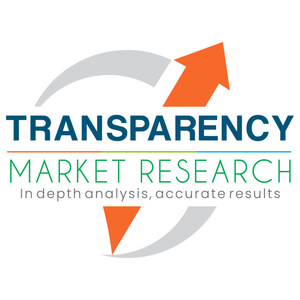- The textile chemicals market may gain an upper hand in terms of growth across 2019-2027 on the back of the booming global population and increased consumption of textiles
- The global textile chemicals market is slated to expand at a CAGR of ~4 percent during the assessment period of 2019-2027
ALBANY, N.Y, Nov. 19, 2020 /PRNewswire/ -- The textile chemicals market may harness extensive growth from 2019 to 2027 due to the rise in disposable income and the deepening penetration of organized retail across the globe. The demand for creatively designed textiles, especially from the millennial category may invite great growth prospects for the textile chemicals market during the forecast period of 2019-2027.
Textile chemicals form an important part of the apparel production process. They are added during fabric processing. The chemicals add varied features to textiles such as stain resistance, antimicrobial properties, sweat absorbency, wrinkle resistance, and others. This aspect may bring tremendous growth opportunities for the textile chemicals market.
Request for Covid-19 Impact Analysis on Textile Chemicals Market: https://www.transparencymarketresearch.com/Covid19.php
The researchers at Transparency Market Research (TMR), after a scrutinized study on all the factors related to growth, conclude that the textile chemicals market may expand at a CAGR of ~4 percent during the forecast period of 2019-2027. The global textile chemicals market is expected to attain a valuation of ~US$ 33.4 bn by 2027.
The advent of smart textiles across the globe and the growing focus on improving the functional quality of textile chemicals may bring immense growth prospects for the textile chemicals market. Cost-effectiveness is also a major factor that can prove to be a game-changer for the textile chemicals market during the assessment period of 2019-2027.
Download PDF Brochure - https://www.transparencymarketresearch.com/sample/sample.php
Textile Chemicals Market: Analysts View
The analysts at Transparency Market Research expect the textile chemicals market to gain immensely on the back of the novel trends across the forecast period of 2019-2027. The analysts further state the growing focus of the companies on inorganic strategies such as mergers and acquisitions. The analysts' further advise the players in the textile chemicals market to introduce new manufacturing techniques such as CO2-dyeing that eliminates the need for chemical and water dyes.
Purchase Premium Research Report on Textile Chemicals Market @ https://www.transparencymarketresearch.com/checkout.php
Textile Chemicals Market: Key Revelations
- On the basis of product, coating and sizing chemicals, finishing agents, and dyes and dyestuff are extrapolated to be leading segments across the textile chemicals market during the assessment period
- Based on application, the technical textiles segment is expected to expand at a CAGR of ~3 percent across the forecast period of 2019-2027
- Asia Pacific acquired a major share of the global textile chemicals market in 2018 and is expected to follow the same trend between 2019 and 2027
- China led the Asia Pacific's textile chemicals market, acquiring more than 40 percent of the market share in 2018
View Detailed Table of Contents at https://www.transparencymarketresearch.com/report-toc/205
Textile Chemicals Market: Growth Boosters
The sustainability factor is penetrating deep across the textile chemicals market. This aspect may prove to be a great growth generator for the textile chemicals market during the forecast period of 2019-2027.
- Manufacturers in the textile chemicals market are focusing on strengthening their online presence, eventually leading to growth as the influence of e-commerce is rising day-by-day
- Large spends on home furnishing textiles and floor coverings due to increased disposable income may turn the tables of growth
Textile Chemicals Market: Growth Dampeners
Stringent regulations on the use of chemicals like chlorine bleach, VOCs, and formaldehyde may serve as a prominent obstacle in the growth of the textile chemicals market. The ban on these chemicals is due to the health issues caused due to them. However, research is in full throttle to explore eco-friendly chemicals that can provide the same benefits as traditional chemicals.
Browse More Press Releases: https://www.transparencymarketresearch.com/press-releases.htm
Global Textile Chemicals Market: Segmentation
By Product
- Coating & Sizing Chemicals
- Wetting Agents
- Defoamers
- Others (Softening Agents, Adhesives, and Antimicrobial Agents)
- Dyes & Dyestuff
- Acid Dyes
- Basic Dyes
- Direct Dyes
- Disperse Dyes
- Reactive Dyes
- Sulfur Dyes
- Vat Dyes
- Others (Including Mordant Dyes and Azo Dyes)
- Finishing Agents
- Surfactants
- De-sizing Agents
- Bleaching Agents
- Yarn Lubricants
- Others (Including Scouring Agents, Leveling Agents, Fixing Agents)
By Application
- Home Furnishing
- Textiles
- Carpets & Rugs
- Furniture
- Others
- Technical Textiles
- Agrotech
- Geotech
- Meditech
- Others (Including Buildtech, Clothtech, Hometech)
- Apparel
- Industrial Textiles
By Region
- North America
- Europe
- Asia Pacific
- Latin America
- Middle East & Africa
Browse Latest Reports by TMR: https://www.transparencymarketresearch.com/latest.htm
Explore Transparency Market Research's award-winning coverage of the global Chemicals and Materials Industry,
Petrochemicals Market - In terms of value, the global petrochemicals market is anticipated to expand at a CAGR of 4% from 2020 to 2030. Petrochemicals are an important part of commodities that are used in daily lives. Petrochemical products are used in various end-use industries, ranging from manufacturing to consumer goods. These chemical compounds are derived from petroleum as well as other hydrocarbons, which are obtained from natural gas and crude oil. Petrochemical products are primarily used as chemical building blocks in various applications and materials. Various organic chemicals are manufactured in the petrochemicals industry. These include methanol, ethylene, butadiene, propylene, benzene, xylene, and toluene. Ethylene, butadiene, and propylene, along with butylene, are collectively called olefins. These belong to a class of unsaturated aliphatic hydrocarbons with chemical formula CnH2n. Benzene, xylene, and toluene are commonly referred to as aromatics. These are unsaturated cyclic hydrocarbons containing multiple rings. Olefins, methanol, and aromatics are precursors to various chemical products; and are generally referred to as primary petrochemicals.
Oleic Acid Market - Based on value, the global oleic acid market is anticipated to expand at a CAGR of 3.5% from 2020 to 2030 and cross value of US$ 400 Mn by 2030. In terms of production and consumption, Asia Pacific led the global oleic acid market in 2019. This trend is expected to continue from 2020 to 2030. Rise in global consumption of palm-based oleochemical products and increase in demand for oleic acid in processed food and demand for oleic acid in personal care products are estimated to boost the overall demand for oleic acid during the forecast period.
Aluminum Potassium Sulfate Market - The wastewater treatment process helps convert wastewater into effluents. Currently, various advanced treatment solutions are available to treat wastewater. Aluminum potassium sulfate is one such chemical used by industries to treat wastewater. Aluminum potassium sulfate is used as a flocculant in water treatment. Addition of flocculants to raw water causes colloids and other suspended particles to stick together and form heavier particles (floc), which are removed by sedimentation or filterability. The flocculation (or called coagulation) process helps in the removal of contaminants such as fine solid pollutants or microscopic molecules that are difficult to remove through filtration alone. Therefore, rise in usage of aluminum potassium sulfate to treat water is expected to drive the aluminum potassium sulfate market during the forecast period.
Textile Binders Market - In terms of value, the global textile binders market is anticipated to expand at a CAGR of ~4% from 2020 to 2030. Textile binders are used in printing paste to print several types of natural fibers such as silk, cotton, wool, and viscose due to their ability to react with chemicals in printing paste in order to bond colors to fibers after being steamed. Additionally, textile binders provide high wash fastness that enables color retention even after washing. Pigment dyes are the independent type of fibers that are utilized to print on synthetic and natural fabrics. Additionally, these dyes are primarily utilized in traditional printing techniques, as the process is highly economical.
Explore More Upcoming Reports: https://www.transparencymarketresearch.com/upcoming.htm
About Transparency Market Research
Transparency Market Research is a global market intelligence company, providing global business information reports and services. Our exclusive blend of quantitative forecasting and trends analysis provides forward-looking insight for thousands of decision makers. Our experienced team of analysts, researchers, and consultants use proprietary data sources and various tools and techniques to gather and analyze information.
Our data repository is continuously updated and revised by a team of research experts, so that it always reflects the latest trends and information. With a broad research and analysis capability, Transparency Market Research employs rigorous primary and secondary research techniques in developing distinctive data sets and research material for business reports.
Contact
Mr. Rohit Bhisey
Transparency Market Research
State Tower,
90 State Street,
Suite 700,
Albany NY - 12207
United States
USA - Canada Toll Free: 866-552-3453
Email: sales@transparencymarketresearch.com
Press Release Source: https://www.transparencymarketresearch.com/pressrelease/textile-chemicals-market.htm
Website: http://www.transparencymarketresearch.com
Logo: https://mma.prnewswire.com/media/1085206/Transparency_Market_Research_Logo.jpg



Share this article